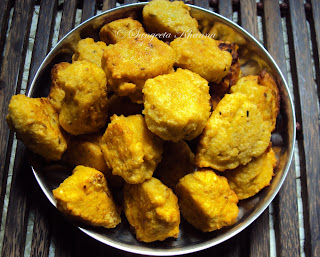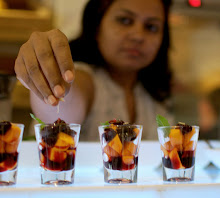Til ki chikki is one winter treat I always look forward to. And I amke it minimally sweet just as my dadi used to make them. Yes, this is one sweet treat where you don't have to worry about the portion size at all. The sweetening is so minimal and that too with natural brown sugar or jaggery, that it's just a hint of sweet and you get a rich nutty taste of sesame all the way. A rich taste that satiates big time.
This recipe always brings back memories of my grandmother. She used to make huge quantities of this Til ke laddoo and it used to be the happiest of the times. My mother never made these but I used to watch my grandmother make them perfectly year after years, roasting the sesame, bubbling the jaggery and then mixing them together before binding them into laddoos (balls) which was the toughest task as the hot mixture would hurt the palms and the sticky nature of hot jaggery would make it really difficult to roll the balls. She would wet her hands in cold water n make small balls tirelessly. She was the most happy when she made such treats for us. Worth mentioning that she lived a hundred and six years all because of healthy food, active life and a very positive attitude towards life that she had. Fond memories.
I started making these laddoos as soon as a started missing them in winters. That was just after we got married 13 years ago. The husband loves all types of sesame and jaggery preparations going by the names like Gajak from western UP, Til ki patti from eastern UP, Tilkut from Bihar and Tilgul from Maharshtra and Til-mungfali ki patti found all over the country I guess. He used to bring home all such sesame brittle in large quantities and I would always tell him they were not good as I had tasted better things at home.
As a new homemaker I was a bit apprehensive to try such a difficult looking recipe but my craving for that nostalgic taste and the husband's love for everything Til and Gud made me try this in my own little kitchen. The first attempt was not that great as I could not bind the balls perfectly and almost half of the mixture got cold and had to be eaten like a crumble. The taste was perfect as I have an innate sense of bringing the flavors right. After a little practice I learnt how to bind the balls well and what else to do when want to save time. I started making bars with the mixture.
ingredients...
500 gm white sesame
200-250 gm jaggery (I use 200 gm or even less)
2-3 tbsp finely grated fresh ginger root
1 tbsp of plain water (sometimes I even use about 100 ml water and cook the syrup longer*)
ghee to grease the baking tray or plate
procedure...
Dry roast the sesame in a pan on low to medium flame, stirring it all the while. It will be ready in about 10 minutes or as soon as a nutty aroma starts emanating and the color of the white sesame turns a nice golden brown.
Now mix the grated or curled (using a paring knife) jaggery and grated ginger in a heavy pan or kadhai. I use a trusted iron kadhai or a thick base aluminium one for this.
If the jaggery is in small pieces it can be used directly.
Heat these ingredients on high flame with just a tbsp of water and watch the melting of jaggery. The jaggery and ginger mix would cook together, first melting to make a syrup and then bubbling to become a frothy mass.See the picture to get an idea. the mixture gets frothy and smells of caramel and ginger. Looks glossy and makes a string when you drop it through the spatula.
This is the time when you have to tip in all the roasted sesame to it and mix quickly so every grain of sesame is coated with the sticky syrup of jaggery. It is quite an easy thing to do as the minute seeds of sesame get mixed really well. This has to be done quickly and then is the time to either wet your hands with chilled water and shape small balls with the medium hot mixture or to make bars with it.
If you find it difficult to shape balls you can always grease a baking tray or plate with ghee and spread this mixture over it evenly. Press the mixture firmly and smoothen it using a cold and greased knife so it becomes smooth. Here I used a silpat lined baking tray and pressed it using a wooden block. Use butter paper for lining the tray or plate for convenience.
Let the brittle cool down completely, invert on a wooden work surface, peel of the silpat (or butter paper) and cut in desired shapes, using a sturdy knife.
It makes a really tasty and healthy sweet treat even if it doesn't bind well into bars or balls. You can enjoy it like a loose crumble. As it is or sprinkled over your oatmeal or any other porridge breakfast.
It is a typical winter delicacy. Made mostly during Makar Sankranti...but can be enjoyed all through winters.
Binding the sesame seeds with minimal quantity if jaggery needs a lot of practice but it's worth practicing this. It is not a very time consuming process if you make a small quantity like this. Took me half an hour to make a dozen balls and nine huge bars this time.
A new learner might need some more time and may be some more jaggery to start with. You can use as much jaggery as you want. Going up to equal to sesame.
I wrap these bars or squares in butter paper if we are traveling during winters as it makes a nice snack while walking and shopping.... peeling off the butter paper and smelling these bars makes one hungry at once.
Posting this recipe while we are still enjoying our winters so you can try if still wanting to get a healthy Calcium and iron boost. This is essentially winter food , rich and nutritious.
Sesame is nourishing food. Include it in curries if you don't do it already. Or make chutneys with it.
This recipe always brings back memories of my grandmother. She used to make huge quantities of this Til ke laddoo and it used to be the happiest of the times. My mother never made these but I used to watch my grandmother make them perfectly year after years, roasting the sesame, bubbling the jaggery and then mixing them together before binding them into laddoos (balls) which was the toughest task as the hot mixture would hurt the palms and the sticky nature of hot jaggery would make it really difficult to roll the balls. She would wet her hands in cold water n make small balls tirelessly. She was the most happy when she made such treats for us. Worth mentioning that she lived a hundred and six years all because of healthy food, active life and a very positive attitude towards life that she had. Fond memories.
I started making these laddoos as soon as a started missing them in winters. That was just after we got married 13 years ago. The husband loves all types of sesame and jaggery preparations going by the names like Gajak from western UP, Til ki patti from eastern UP, Tilkut from Bihar and Tilgul from Maharshtra and Til-mungfali ki patti found all over the country I guess. He used to bring home all such sesame brittle in large quantities and I would always tell him they were not good as I had tasted better things at home.
As a new homemaker I was a bit apprehensive to try such a difficult looking recipe but my craving for that nostalgic taste and the husband's love for everything Til and Gud made me try this in my own little kitchen. The first attempt was not that great as I could not bind the balls perfectly and almost half of the mixture got cold and had to be eaten like a crumble. The taste was perfect as I have an innate sense of bringing the flavors right. After a little practice I learnt how to bind the balls well and what else to do when want to save time. I started making bars with the mixture.
ingredients...
500 gm white sesame
200-250 gm jaggery (I use 200 gm or even less)
2-3 tbsp finely grated fresh ginger root
1 tbsp of plain water (sometimes I even use about 100 ml water and cook the syrup longer*)
ghee to grease the baking tray or plate
procedure...
Dry roast the sesame in a pan on low to medium flame, stirring it all the while. It will be ready in about 10 minutes or as soon as a nutty aroma starts emanating and the color of the white sesame turns a nice golden brown.
Now mix the grated or curled (using a paring knife) jaggery and grated ginger in a heavy pan or kadhai. I use a trusted iron kadhai or a thick base aluminium one for this.
If the jaggery is in small pieces it can be used directly.
Heat these ingredients on high flame with just a tbsp of water and watch the melting of jaggery. The jaggery and ginger mix would cook together, first melting to make a syrup and then bubbling to become a frothy mass.See the picture to get an idea. the mixture gets frothy and smells of caramel and ginger. Looks glossy and makes a string when you drop it through the spatula.
Let the brittle cool down completely, invert on a wooden work surface, peel of the silpat (or butter paper) and cut in desired shapes, using a sturdy knife.
It is a typical winter delicacy. Made mostly during Makar Sankranti...but can be enjoyed all through winters.
Binding the sesame seeds with minimal quantity if jaggery needs a lot of practice but it's worth practicing this. It is not a very time consuming process if you make a small quantity like this. Took me half an hour to make a dozen balls and nine huge bars this time.
A new learner might need some more time and may be some more jaggery to start with. You can use as much jaggery as you want. Going up to equal to sesame.
Posting this recipe while we are still enjoying our winters so you can try if still wanting to get a healthy Calcium and iron boost. This is essentially winter food , rich and nutritious.
Sesame is nourishing food. Include it in curries if you don't do it already. Or make chutneys with it.




























































